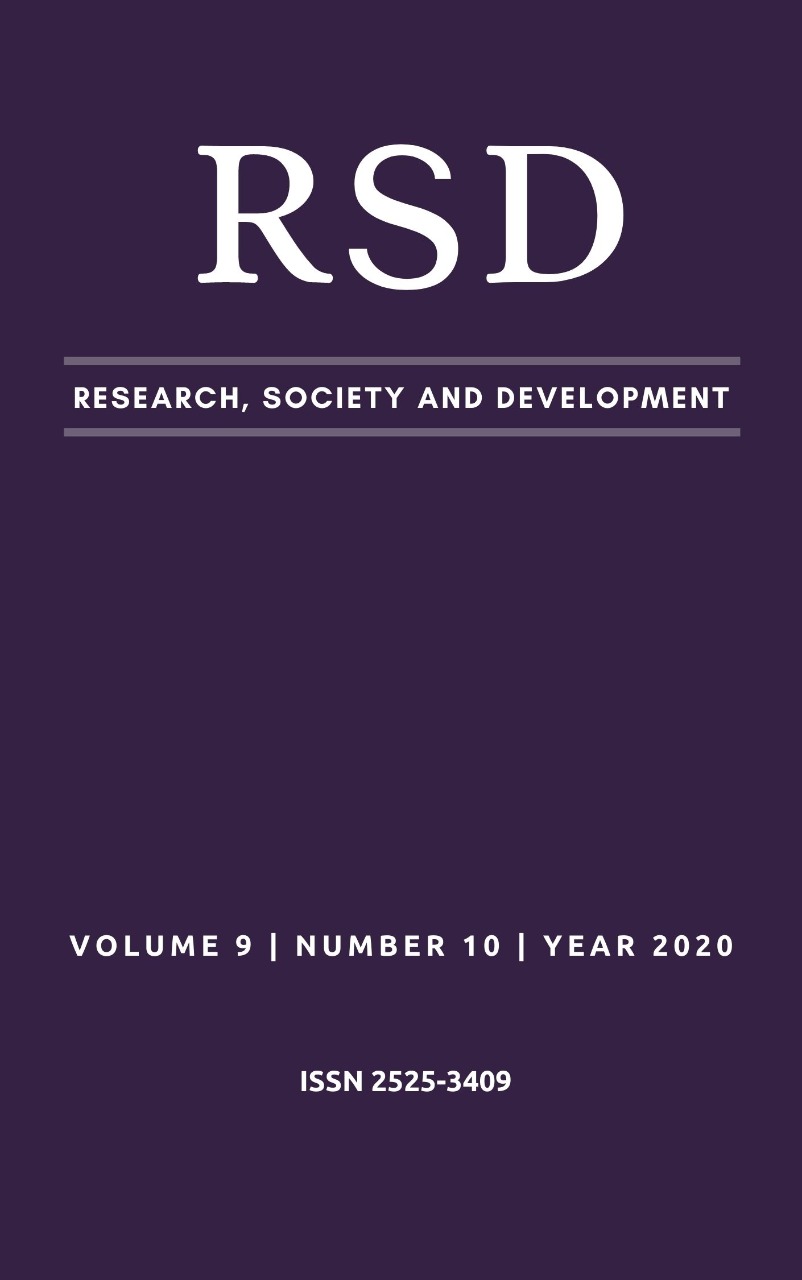Atividade antibacteriana e antifúngica da herbácia Zingiber Officinale em odontologia: uma revisão de literatura
DOI:
https://doi.org/10.33448/rsd-v9i10.9141Palavras-chave:
Agentes antibacterianos; Agentes antifúngicos; Biofilme dental; Zingiber officinale.Resumo
O biofilme dentário patogênico formado por espécies bacterianas e fúngicas e contribui para desenvolvimento doenças orais e corpóreas. Nesse sentido, a odontologia por ampliar o conhecimento sobre o ecossistema oral e realizar procedimentos que visam à reduzir a patogenicidade e melhor a saúde oral. Assim, os avanços tecnológicos e a aplicação indiscriminada de antibióticos tem tornado as cepas bacterianas resistentes, sendo grande a busca por métodos mais seguros, naturais e eficazes. Logo, o uso de plantas aos tratamentos saudáveis é uma área de grande estudo em Odontologia. Na presente revisão de literatura, buscou-se analisar a espécie Zingiber officinale e a atividade antimicrobiana e antibiofilme. Para tal estudo, buscaram-se materiais na Biblioteca Regional da Medicina (BIREME), CINAHL, Cochrane Library, Embase, Google Scholar, PubMed e Science Direct publicados até agosto de 2020. A busca dos artigos foi realizada em agosto do mesmo ano, e dos 3.401 estudos foram refinados em 19. Os achados mostraram que a planta Zingiber officinale tem capacidade de inibir certas bactérias in vitro, como Bacillus sp., Escherichia coli, Pseudomonas aeruginosa, Streptococcus mutans e fungos, como Candida albicans. Dessa forma, ainda são necessários estudos na área, a fim de comprovar sua eficácia in situ e in vivo, analisar a toxicidade, interações medicamentosas e efeitos colaterais da planta.
Referências
Aghazadeh, M., et al. (2016). Survey of the Antibiofilm and Antimicrobial Effects of Zingiber officinale (in Vitro Study). Jundishapur Journal of Microbiology. 9(2), 1-4.
Avcioglu, N. H., Sahal, G., Bilkay, I. S. (2016) Antibiofilm effects of Citrus limonum and Zingiber officinale oils on biofilm formation of Klebsiella ornithinolytica, Klebsiella oxytoca and Klebsiella terrigena species. African Journal of Traditional Complementary Alternative Medicines. 13(6),61-67.
Cavalcante, R. As plantas na Odontologia:Um guia prático. (2019) (3a ed.), Cavalcante,R.
Ghasemzadeh, A., et al. (2018). Formation of 6-, 8- and 10-Shogaol in Ginger through Application of Different Drying Methods: Altered Antioxidant and Antimicrobial Activity. Molecules. 23(7),1-12.
Gregio, A. M. T., et al. (2006). Ação antimicrobiana do Zingiber officinale frente á microbiota bucal. Estudos de Biologia. 28(62), 61-66.
Gull, I., et al. (2012). Inhibitory effect of Allium sativum and Zingiber officinale extracts on clinically important drug resistance pathogenic bacteria. Annals of Clinical Microbiology and Antimicrobials. 11(8), 10-16.
Guo, T., et al. (2017). Two new monoterpenoid glycosides from the fresh rhizome of Tongling White Ginger (Zingiber officinale). Natural Product Research. 32(1), 71-76.
Hasan, S., Danishuddin, M., Khan, A. U. (2015). Inhibitory effect of Zingiber officinale towards Streptococcus mutans virulence and caries development: in vitro and in vivo studies. BMC Microbiology. 15(1), 1-14.
Jain, I., et al. (2015) Use of Traditional Indian Plants in the inhibition of Caries- Causing Bacteria- Streptococcus mutans-. Brazilian Dental Journal. 26(2), 110 115.
Jami, S. G., Araujo, P. D. H. (2017). Efecto antimicrobiano del extracto, aceite de jengibre (zingiber officinale) sobre cepas de enterococcus faecalis: Estudio in vitro. ODONTOLOGÍA. 19(1), 89-97.
Karuppiah, P., Rajaram, S. (2012). Antibacterial effect of Allium sativum cloves and Zingiber officinale rhizomes against multiple-drug resistant clinical pathogens. Asian Pacific Journal of Tropical Biomedicine. 2(8), 597-601.
Kim, H. S., Park, H. D. (2013) Ginger Extract Inhibits Biofilm Formation by Pseudomonas aeruginosa PA14. PLOS ONE. 8(9), 1-16.
Kumar, L., Chhibber, S., Harjai, K. (2013). Zingerone inhibit biofilm formation and improve antibiofilm efficacy of 2 ciprofloxacin against Pseudomonas aeruginosa PAO1. Fitoterapia. 90, 73-78.
Lee, J. H., et al. (2018). Antibiofilm and Antivirulence Activities of 6-Gingerol and 6-Shogaol Against Candida albicans Due to Hyphal Inhibition. Frontiers in Cellular and Infection Microbiology. 8(299), 1-10.
Marsh & Martin. Microbiologia Oral. (6a ed.), Elsevier Health Science, 2018.
Miari, et al. (2020) Natural products and polysorbates: Potential Inhibitors of biofilm formation in Pseudomonas aeruginosa. The Journal of infection Developing Countries. 14(6), 580-588.
Park, M., Jungdon, B. A. E, Dae-Sil L. E. E. (2008) Antibacterial Activity of [10]-Gingerol and [12]-Gingerol isolated from Ginger Rhizome Against Periodontal Bacteria. Phytotherapy Research. 22(11), 1446-1449.
Pereira, A. S., et al. (2018). Metodologia da pesquisa científica. [e-book]. Santa Maria. Ed. UAB/NTE/UFSM.
Pozzati, P., et al.(2008). In vitro activity of essential oils extracted from plants used as spices against fluconazole-resistant and fluconazole-susceptible Candida spp. Canadian Journal of Microbiology. 54(11), 950- 956.
Rampogu, S., et al. (2018). Ginger (Zingiber officinale) phytochemicals gingerenone ‑A and shogaol inhibit SaHPPK: molecular docking, molecular dynamics simulations and in vitro approaches. Annals of Clinical Microbiology and Antimicrobials. 17(1), 1-15.
Valera, M. C., et al. (2016). Action of Chlorhexidine, Zingiber officinale on Candida albicans, Enterococcus faecalis, Escherichia coli, and Endotoxin in the Root canals. The Journal of Contemporary Dental Practice. 17(2), 114-118.
Downloads
Publicado
Como Citar
Edição
Seção
Licença
Copyright (c) 2020 Natália Franco Brum; Mariana Sobreira Bezerra; Aline Sobreira Bezerra; Gabriela Scortegagna de Souza; Patricia Kolling Marquezan

Este trabalho está licenciado sob uma licença Creative Commons Attribution 4.0 International License.
Autores que publicam nesta revista concordam com os seguintes termos:
1) Autores mantém os direitos autorais e concedem à revista o direito de primeira publicação, com o trabalho simultaneamente licenciado sob a Licença Creative Commons Attribution que permite o compartilhamento do trabalho com reconhecimento da autoria e publicação inicial nesta revista.
2) Autores têm autorização para assumir contratos adicionais separadamente, para distribuição não-exclusiva da versão do trabalho publicada nesta revista (ex.: publicar em repositório institucional ou como capítulo de livro), com reconhecimento de autoria e publicação inicial nesta revista.
3) Autores têm permissão e são estimulados a publicar e distribuir seu trabalho online (ex.: em repositórios institucionais ou na sua página pessoal) a qualquer ponto antes ou durante o processo editorial, já que isso pode gerar alterações produtivas, bem como aumentar o impacto e a citação do trabalho publicado.

